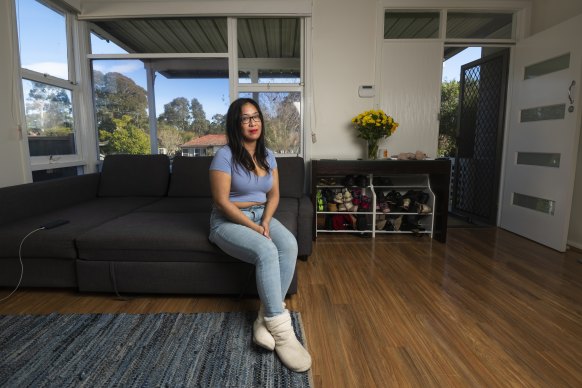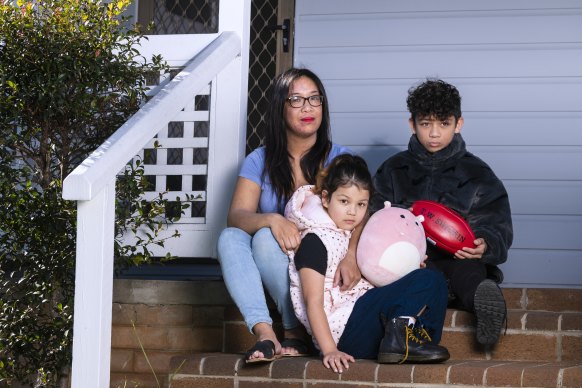Save articles for later
Add articles to your saved list and come back to them any time.
Key points
- Sydney’s median unit rent has jumped by $145 over the past year to $670 per week.
- House rent reached a median of $700, increasing by $80 annually.
- Sharp rent increases are forcing some tenants to leave their community behind.
Property listings
Sydney unit rents have soared by $145 a week over the past year, putting pressure on household budgets already stretched by other rising costs.
Asking rent for the median apartment reached a record $670 a week after an increase of 8.1 per cent over the June quarter alone and 27.6 per cent over the past year, the latest Domain Rent Report released on Thursday shows.
Renters such as Raelene Gutierrez are being forced to leave their communities behind to find an affordable rental property.Credit: Rhett Wyman
It marks the steepest jump on Domain records, dating to 2004, and the longest stretch of unit rent rises – now at eight consecutive quarters.
House rents also reached new highs, increasing 6.1 per cent over the quarter to a median asking rent of $700, up 12.9 per cent over the year.
Domain’s chief of research and economics Dr Nicola Powell said rent increases gained pace over the quarter despite an uptick in the rental vacancy rate, which reached 1.2 per cent in June – up from a low of 0.9 per cent.
“It hasn’t been enough to ease the tight conditions caused by the mismatch between supply and demand,” Powell said.
Rental demand increased as the number of people per household declined, overseas migration and international students returned, and home ownership became unreachable for more Australians, Powell said.
Planning and construction industry pain points slowed new housing and investor activity had been sluggish.
Apartment rents were up 36.4 per cent annually in the inner south-west, 33.3 per cent in the Parramatta region and city and inner south, and 30.8 per cent in the inner west.
House rents were up 29.2 per cent – or $350 a week – in the eastern suburbs, though prices stabilised over the quarter, which Powell said could indicate affordability constraints.
“Rents in a couple of areas flatlined over the quarter … if people are priced out they shift property type or location … the ceiling [for asking rents] is being reached,” she said.
“What we might see is a consolidation of households, and we’re probably starting to see that in certain pockets.”
Corporate travel agent Raelene Gutierrez moved further west this year after her landlord raised the rent on her Parramatta unit by $50 a week despite its mould issues during Sydney’s rainy spell.
“I remember getting the email and I cried. And it wasn’t that big of an increase, but it was too much for me,” she said, adding neighbours in the same block received increases as high as $200.
Raelene Gutierrez, with daughter Sophia and son Leo, moved from Parramatta to Toongabbie after her rent increased.Credit: Rhett Wyman
Gutierrez, 38, has rented in Sydney for about 15 years, mostly in Parramatta, but moved to Toongabbie after spending months looking at about 50 rental properties. She also asked her partner to move in to share costs.
“They were all either too expensive or not maintained or just completely not suitable for two children, myself and a partner,” she said.
Hight rents made it impossible to save enough for a home deposit, she said.
“You needed to have done that a decade ago or two decades ago when the rental market was OK, and the price of housing was OK, and the salaries you were earning were appropriate for the market. It’s just not possible now,” she said.
“We just hope to god that in 12 months’ time the rent doesn’t increase that much.”
ANZ senior economist Adelaide Timbrell said the combination of strong population growth and sluggish housing supply had resulted in low vacancies, enabling investors to charge more for rentals.
Higher mortgage rates may be a trigger for some increases, as landlords passed on increased costs, but were not the main factor.
Timbrell expected rent rises could slow as households made changes to cope with deteriorating housing affordability.
“If people use less space or share homes among more people for affordability reasons, this will offset some of the increase in demand which is pushing rents up.”
Centre for Independent Studies chief economist Dr Peter Tulip said there was little to suggest rent growth would slow or reverse short-term given the forecast high migration and low housing completions.
He said the record rise in rents was troubling, as it would lead to a higher rate of homelessness.
“This is just another reason why we need better housing policy on state and federal levels to make housing more affordable, which will especially benefit those at the bottom of the market.”
Tulip said increasing new housing supply, by removing planning red tape, was the key to addressing the rental crisis.
Most Viewed in Property
Source: Read Full Article



